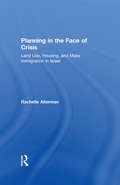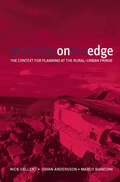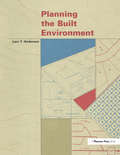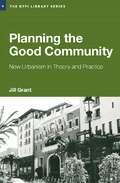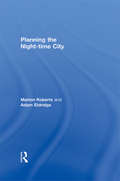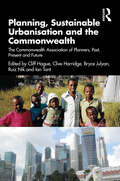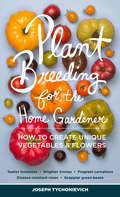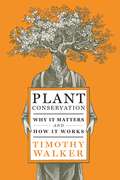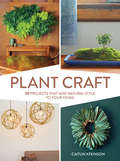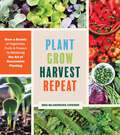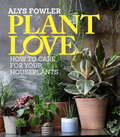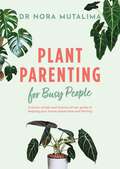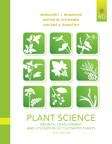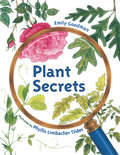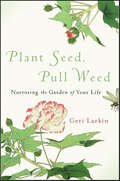- Table View
- List View
Planning in Plain English: Writing Tips for Urban and Environmental Planners
by Natalie MacrisIn this volume, the author draws from more than a decade of editing experience to explain how to craft clear, understandable, and highly readable planning documents. The author suggests ways to overcome planners' most common writing foibles: acronymns, jargon, and overuse of the passive voice. And the author provides handy lists to transform mushy nouns into powerful verbs, pare down bloated sentences, and translate ""bureaucratese"" into everyday language. The author even includes practice exercises designed to help you recognize and overcome bad writing habits. But even the best writing skills won't help if your document is organized poorly and aimed at the wrong audience.The author also explains why it's essential to know who your readers are before you start writing and how to organize your work so that it will be easy to understand and use."
Planning in Postmodern Times (RTPI Library Series)
by Philip AllmendingerPostmodern social theory has provided significant insights into our understanding of society and its components. Key thinkers including Foucault, Baudrillard and Lyotard have challenged existing ideas about power and rationality in society. This book analyses planning from a postmodern perspective and explores alternative conceptions based on a combination of postmodern thinking and other fields of social theory. In doing so, it exposes some of the limits of postmodern social theory while providing an alternative conception of planning in the twenty-first century.This title will appeal to anyone interested in how we think and act in relation to cities, urban planning and governance.
Planning in the Face of Crisis: Land Use, Housing, and Mass Immigration in Israel (Cities And Regions Ser.)
by Rachelle AltermanCritics of urban and regional planning argue that it is best suited to manage incremental change. Can a planner's skills and expertise be effective in handling a major crisis and large-scale change? The mass immigration from the former Soviet Union to Israel in the 1990s offers the opportunity to study one of the largest-scale (non-disaster) crisis situations in a democratic, advanced-economy country. This book recounts the fascinating saga of how policymakers and planners at both the national and local levels responded to the formidable demand for housing and massive urban growth. Planners forged new housing and land-use policies, and applied a streamlined (but controversial) planning law. The outputs were impressive. The outcomes and impacts changed the landscape and human-scape of Israel, heightening dilemmas of land use and urban policy in this high-density country.
Planning on the Edge
by Johan Andersson Nick Gallent Marco BianconiMore than a tenth of the land mass of the UK comprises 'urban fringe': the countryside around towns that has been called 'planning's last frontier'. One of the key challenges facing spatial planners is the land-use management of this area, regarded by many as fit only for locating sewage works, essential service functions and other un-neighbourly uses. However, to others it is a dynamic area where a range of urban and rural uses collide. Planning on the Edge fills an important gap in the literature, examining in detail the challenges that planning faces in this no-man’s land. It presents both problems and solutions, and builds a vision for the urban fringe that is concerned with maximising its potential and with bridging the physical and cultural rift between town and country. Its findings are presented in three sections: the urban fringe and the principles underpinning its management sectoral challenges faced at the urban fringe (including commerce, energy, recreation, farming, and housing) managing the urban fringe more effectively in the future. Students, professionals and researchers alike will benefit from the book's structured approach, while the global and transferable nature of the principles and ideas underpinning the study will appeal to an international audience.
Planning the Built Environment
by Larz AndersonPlanning the Built Environment takes a systematic, technical approach to describing how urban infrastructures work. Accompanied by detailed diagrams, illustrations, tables, and reference lists, the book begins with landforms and progresses to essential utilities that manage drainage, wastewater, power, and water supply. A section on streets, highways, and transit systems is highly detailed and practical. Once firmly grounded in these "macro" systems, Planning the Built Environment examines the physical environments of cities and suburbs, including a discussion of critical elements such as street and subdivision planning, density, and siting of community facilities. Each chapter includes essential definitions, illustrations and diagrams, and an annotated list of references. This timely book explains new physical planning methods and current thinking on cluster development, new urbanism, and innovative transit planning and development. Planners, architects, engineers, and anyone who designs or manages the physical components of urban areas will find this book both an authoritative reference and an exhaustive, understandable technical manual of facts and best practices. Instructors in planning and allied fields will appreciate the practical exercises that conclude each chapter: valuable learning tools for students and professionals alike.
Planning the Good Community: New Urbanism in Theory and Practice (RTPI Library Series)
by Jill GrantAn examination of new urban approaches both in theory and in practice. Taking a critical look at how new urbanism has lived up to its ideals, the author asks whether new urban approaches offer a viable path to creating good communities. With examples drawn principally from North America, Europe and Japan, Planning the Good Community explores new urban approaches in a wide range of settings. It compares the movement for urban renaissance in Europe with the New Urbanism of the United States and Canada, and asks whether the concerns that drive today’s planning theory – issues like power, democracy, spatial patterns and globalisation- receive adequate attention in new urban approaches. The issue of aesthetics is also raised, as the author questions whether communities must be more than just attractive in order to be good. With the benefit of twenty years’ hindsight and a world-wide perspective, this book offers the reader unparalleled insight as well as a rigorous and considered critical analysis.
Planning the Great Metropolis: The 1929 regional plan of New York and its environs (Planning, History and Environment Series)
by David A. JohnsonAs the Regional Plan Association embarks on a Fourth Regional Plan, there can be no better time for a paperback edition of David Johnson’s critically acclaimed assessment of the 1929 Regional Plan of New York and Its Environs. As he says in his preface to this edition, the questions faced by the regional planners of today are little changed from those their predecessors faced in the 1920s. Derided by some, accused by others of being the root cause of New York City’s relative economic and physical decline, the 1929 Plan was in reality an important source of ideas for many projects built during the New Deal era of the 1930s. In his detailed examination of the Plan, Johnson traces its origins to Progressive era and Daniel Burnham’s 1909 Plan of Chicago. He describes the making of the Plan under the direction of Scotsman Thomas Adams, its reception in the New York Region, and its partial realization. The story he tells has important lessons for planners, decision-makers and citizens facing an increasingly urban future where the physical plan approach may again have a critical role to play.
Planning the Night-time City
by Marion Roberts Adam EldridgeThe night-time economy represents a particular challenge for planners and town centre managers. In the context of liberalised licensing and a growing culture around the '24-hour city', the desire to foster economic growth and to achieve urban regeneration has been set on a collision course with the need to maintain social order. Roberts and Eldridge draw on extensive case study research, undertaken in the UK and internationally, to explain how changing approaches to evening and night-time activities have been conceptualised in planning practice. The first to synthesise recent debates on law, health, planning and policy, this research considers how these dialogues impact upon the design, management, development and the experience of the night-time city. This is incisive and highly topical reading for postgraduates, academics and reflective practitioners in Planning, Urban Design and Urban Regeneration.
Planning, Markets and Rural Housing
by Nick GallentThis book analyses the key forces affecting the affordability of rural homes in Britain and the changing shape of housing markets. It takes as its starting point, demographic trends impacting upon rural communities and upon market dynamics. From this point, it explores consequent patterns of housing affordability, examining changing opportunities in the rental and sale markets, at different spatial scales. The book also focuses on how markets are analysed, and how data are selectively used to demonstrate low levels of affordability, or a lack of need for additional housing in small village locations.Building on the demographic theme, the book considers the housing implications of an aging population, before the focus finally shifts to community initiative in the face of housing undersupply and planning's future role in delivering and procuring a more constant and predictable supply of affordable homes. In a speculative conclusion, the book ends by examining the current political trajectory in England, and the prospects for housing in the countryside in the context of localism and neighbourhood planning at a village level.This book was published as a special issue of Planning Practice and Research.
Planning, Sustainable Urbanisation and the Commonwealth: The Commonwealth Association of Planners, Past, Present and Future
by Cliff Hague Clive Harridge Bryce Julyan Ruiz Nik Ian TantBy 2050, an additional 2.5 billion people will be living in the world’s towns and cities, almost 50% of them in the 56 Commonwealth countries. To a significant extent, the future of the planet hangs on how cities and human settlements are managed. It is in our cities that the emissions creating climate catastrophe are stoked and where change can – and must – make a difference at scale. Food security, water, basic services, migration, shelter, jobs, environment: sustainable urbanisation is about changing direction to strive for a fairer and less environmentally damaging future. This well-illustrated book by authors from around the Commonwealth tells how the Commonwealth Association of Planners across five decades has campaigned to make a difference. It also looks ahead, scoping the urgent, practical action that is now required.
Plant Breeding for the Home Gardener: How to Create Unique Vegetables and Flowers
by Joseph TychonievichBrighter zinnias, fragrant carnations, snappier green beansPlant Breeding for the Home Gardener makes it easier than ever to breed and grow your own varieties of vegetables and flowers. This comprehensive and accessible guide explains how to decide what to breed, provides simple explanations on how to cross plants, and features a basic primer on genetics and advanced techniques. Case studies provide breeding examples for favorite plants like daffodils, hollyhocks, roses, sweet corn, and tomatoes.
Plant Conservation: Why It Matters and How It Works
by Timothy WalkerPlants’ ability to turn sunlight into energy makes them the basis for all life; without them there is no life. And they are more than just a food source—they provide us with fuel, fibers, and pharmaceuticals. Global warming and the destruction of natural habitats are a serious threat to many plants, and there are worldwide efforts to mitigate the disaster. Plant Conservation tackles this essential topic head on. Timothy Walker, as the director of the Oxford Botanical Garden, a leader in the field of plant conservation, plays a key role in this effort. He highlights what is happening now, from cataloging the world’s flora to conservation efforts like protecting plants from overcollecting. He also shows home gardeners how they can become involved, whether by growing their own food to decrease reliance on large agriculture or by making smart plant choices by growing natives and avoiding invasives. Plant Conservation treats a critical topic in an accessible and optimistic way. It is required reading for students, professionals, and anyone with a keen interest in the importance of plants.
Plant Craft: 30 Projects that Add Natural Style to Your Home
by Caitlin AtkinsonDiscover the simple beauty of adding natural style to a space! Not everyone has a garden—but with only a handful of materials and a little bit of time, everyone can bring the beauty of nature into their home. Plant Craft features projects inspired by the natural world and made out of live plants, cut flowers, foraged branches, and more. You’ll learn how to create a colorful floral mural, an elegant table centerpiece, a serene underwater sculpture, a whimsical mobile, and more. The step-by-step instructions are clear, easy to follow, and fully illustrated with color photographs, and the projects vary in difficulty. Given the right care, they all have the potential to grace a home for a long time.
Plant Grow Harvest Repeat: Grow a Bounty of Vegetables, Fruits, and Flowers by Mastering the Art of Succession Planting
by Meg McAndrews Cowden&“Wonderfully written, beautifully illustrated, and everything you need to know to get more productivity out of your food garden.&” —Joe Lamp&’l, creator and executive producer, Growing a Greener World Discover how to get more out of your growing space with succession planting—carefully planned, continuous seed sowing—and provide a steady stream of fresh food from early spring through late fall. Drawing inspiration from succession in natural landscapes, Meg McAndrews Cowden teaches you how to implement lessons from these dynamic systems in your home garden. You&’ll learn how to layer succession across your perennial and annual crops; maximize the early growing season; determine the sequence to plant and replant in summer; and incorporate annual and perennial flowers to benefit wildlife and ensure efficient pollination. You&’ll also find detailed, seasonal sowing charts to inform your garden planning, so you can grow more anywhere, regardless of your climate. Plant Grow Harvest Repeat will inspire you to create an even more productive, beautiful, and enjoyable garden across the seasons—every vegetable gardener&’s dream.
Plant Love
by Alys FowlerHouseplants are more than just decorations. They turn a room into a living space and breathe life into our interiors. Not all of us can have a garden or even a window box, but everyone can own a houseplant - and everyone should. Not only are they an affordable and attractive way to add a decorative and personal touch to a space, indoor plants also have unique air purifying properties and their presence is good for our health and wellbeing. In this practical yet inspiring guide, gardening expert Alys Fowler explores all the possible indoor plant options available, helping you to find the perfect plant for any location, from cool, shady bedrooms to warm, sunny kitchen windowsills. As well as more traditional indoor plants, Alys looks at specialist plant groups such as indoor tropical edibles, orchids, cacti, succulents and climbers. With her encyclopedic knowledge and trademark inspirational style, this definitive guide will give you all the knowledge you need to care for your plants.
Plant Love
by Alys FowlerHouseplants are more than just decorations. They turn a room into a living space and breathe life into our interiors. Not all of us can have a garden or even a window box, but everyone can own a houseplant - and everyone should. Not only are they an affordable and attractive way to add a decorative and personal touch to a space, indoor plants also have unique air purifying properties and their presence is good for our health and wellbeing. In this practical yet inspiring guide, gardening expert Alys Fowler explores all the possible indoor plant options available, helping you to find the perfect plant for any location, from cool, shady bedrooms to warm, sunny kitchen windowsills. As well as more traditional indoor plants, Alys looks at specialist plant groups such as indoor tropical edibles, orchids, cacti, succulents and climbers. With her encyclopedic knowledge and trademark inspirational style, this definitive guide will give you all the knowledge you need to care for your plants.
Plant Parenting for Busy People
by Nora MutalimaIt's one thing to fill your house with gorgeous plants; it's another to keep them happy for weeks, months and years. Medical doctor and passionate plant lover Nora Mutalima offers a simple, science-driven guide to creating your own indoor jungle and keeping it thriving with minimal effort.Create the perfect environment: Learn how your home layout affects plant health and discover easy switches that will turn your black thumb green.Find your style: Are you a Nurturer or a Minimalist? A Decorator or a Rescuer? Don't change yourself for that fiddle-leaf fig – learn your plant parenting style so you can choose plants that will love you just as you are.Set up your systems: Discover how making smart choices at the start can create a lush indoor garden that only needs a simple, bare-minimum routine to flourish.Avoid common stumbling blocks: Arrive armed and prepared for the pests and watering problems that plague many new gardeners.Try something new: Take the fear factor out of semi-hydroponics and discover how switching from potting mix to LECA could make your life easier and far less messy – with incredible results.Featuring clear advice and step-by-step activities, this is a fun and approachable guide to indoor plant care from YouTube sensation @TheLecaQueen. Perfect for everyone from seasoned gardeners keen to explore new techniques to new plant parents who just want their monstera to survive the year.
Plant Parenting: Easy Ways to Make More Houseplants, Vegetables, and Flowers
by Leslie F. Halleck“Everything a plant parent needs to take their plant collection—and plant knowledge—to the next level.” —Maria Failla, founder, Bloom & Grow Radio podcast Do you have a passion for houseplants? A desire to grow more tomatoes? Do you want a garden bursting with colorful flowers? No matter what kind of plant fan you are, it’s easy to make more of your favorite plants—and it can be done for free! Plant Parenting is a beginner-friendly introduction to plant propagation. Leslie F. Halleck details the basic tools necessary, demystifies seed starting and saving, and shares easy-to-follow instructions for the most practical techniques for cutting, layering, dividing, and more. She also provides additional information on controlling pests and diseases and transplanting seedlings and cuttings. Charming, richly illustrated, and accessible, Plant Parenting is for anyone looking to make more of their favorite plants.
Plant Partners: Science-Based Companion Planting Strategies for the Vegetable Garden
by Jessica WalliserCompanion planting has a long history of use by gardeners, but the explanation of why it works has been filled with folklore and conjecture. Plant Partners delivers a research-based rationale for this ever-popular growing technique, offering dozens of ways you can use scientifically tested plant partnerships to benefit your whole garden. Through an enhanced understanding of how plants interact with and influence each other, this guide suggests specific plant combinations that improve soil health and weed control, decrease pest damage, and increase biodiversity, resulting in real and measurable impacts in the garden. This publication conforms to the EPUB Accessibility specification at WCAG 2.0 Level AA.
Plant Power
by Laurel DeweyPLANT POWER is your one-stop guide to effectively growing and using thirty great medicinal herbs. Offering first-hand knowledge and years of herbal experience, author Laurel Dewey (aka "The Humorous Herbalist") leads readers on a step-by-step journey that takes you from your own backyard and into the wild green yonder. Learn when to plant seeds, what time of year is best for harvesting, which parts of the plant are the most medicinally potent, and how to preserve herbs for later use. Discover timesaving secrets on ways to avoid common herb garden mistakes and how to get the most out of your medicinal bounty. As an added bonus, you will learn which herbs can be sliced, diced, and pounded into "wild food" recipes that contain vitamins, minerals, and energy-sustaining protein.Everything you need to become "herbally" self-sufficient is here:* Why would you want to purposely sting yourself with a stinging nettle?* What can alfalfa and red clover do to improve poor garden soil?* When does usnea, a common tree fungus, turn into an incredible anti-viral agent?* Would you believe that pine sap could prevent infections in a wound?* How can "weeds" such as burdock, chickweed, and yellow dock keep you healthy and full of energy?The answers to these and other herbal questions are at your fingertips. So, grab a shovel, get some seeds, and start that medicinal garden.
Plant Powered Cooking: 52 Inspired Ideas for Growing and Cooking Yummy Good Food
by Alice Alvrez&“Truly delectable veggie recipes for healthy living&” and starter garden tips from the author of The Going Green Handbook (Mielle Rose, author of Veganish). Organic gardener, environmentalist, and pop-up chef Alice Mary Alvrez wants to make it as easy as possible to reduce your footprint, grow and eat fabulous organic vegetables, and maintain a planet-positive, animal-friendly lifestyle. As she says, &“I like to make it so simple that it&’s brain-free so you don&’t even have to think about it any more, you fall in love with a healthier and greener way of life.&” Her book, Plant Powered Cooking is simply brimming with brilliant ideas you can use from tips for growing your own food (even if you have a hard time keeping houseplants alive), shopping and cooking techniques for every mealtime, and even low-labor secrets for harvesting and canning the bounty from your own garden. Learn surprising facts about the impact of meat and animal products on the environment and how even small do-it-yourself ideas lead to real impact. Begin with small changes such as &“Meat-free Mondays,&” then eliminate all meat out of your diet and replace it with beautiful food grown by your own hand. With Alvrez&’s Plant Powered Cooking, you and your family will be living the good life. &“Inspired ideas for healthy eating.&” —Billee Sharp, author of Lemons and Lavender
Plant Science: Growth, Development, And Utilization Of Cultivated Plants
by Margaret McMahonThorough foundation in plant cultivation suitable for learners of all levels Plant Science: Growth, Development, and Utilization of Cultivated Plants is the premier resource on the basic principles of ecological relationships and their impact on cultivation. Comprehensive and engaging, Plant Science addresses all relevant topics, from the fundamentals of botany to complex cultivation strategies and sustainability concerns. The breadth of topics covered by this text make it ideal for most plant science courses, including the combined agronomy-horticulture curricula that universities are increasingly adopting. The 6th edition has been updated with a wealth of new information, images, and features, and now draws a stronger connection between natural, agricultural, and horticultural ecosystems.
Plant Science: Growth, Development, and Utilization of Cultivated Plants
by Margaret E. Mcmahon Anton M. Kofranek Vincent E. RubatzkyPlant Science: Growth, Development, and Utilization of Cultivated Plants, Fifth Edition, is an outstanding resource for anyone with an interest in how plants are grown and utilized for maintaining and adding enjoyment to human life. The text starts with the fundamentals of botany, plant physiology, and environmental factors affecting plant growth, while later sections integrate those topics into strategies of producing plants for human use as food, fiber, and recreation. The concept of sustainability and sustainable methods of growing plants runs throughout the text. Whether you are familiar or unfamiliar with plant science, this book will give you a firm understanding of concepts and terminology related to the growing of plants.
Plant Secrets
by Emily GoodmanYoung scientists will love this nature mystery that reveals the secrets hiding in seeds, plants, flowers, and fruits throughout the life cycle of various flora. Curiosity will bloom in this introduction to botany and primary nature science. Plants come in all shapes and sizes, but they go through the same stages as they grow. Using four common plants, young readers learn about plant structure and life cycle. Simple text and colorful, detailed illustrations show the major phases of plant growth with each stage holding a &“secret&” for curious readers to guess. Back matter offers more information on each plant, as well as greater detail on each stage of growth.
Plant Seed, Pull Weed: Nurturing the Garden of Your Life
by Geri LarkinGardens have often been used as metaphors for spiritual nurturing and growth. Zen rock gardens, monastery rose gardens, even your grandmother's vegetable garden all have been described as places of refuge and reflection. Drawing on her experience working at Seattle's premier gardening center, Zen teacher Geri Larkin shows how the act of gardening can help you uncover your inner creativity, enthusiasm, vigilance, and joy. As your garden grows, so will your spirit.Larkin takes you through the steps of planning, planting, nurturing, and maintaining a garden while offering funny stories and inspiring lessons on what plants can teach us about our lives. As soothing as a bowl of homemade vegetable soup, Plant Seed, Pull Weed will entertain, charm, and inspire you to get your hands dirty and dig deep to cultivate your inner self.


